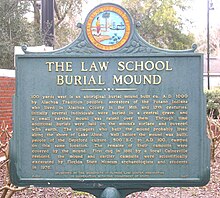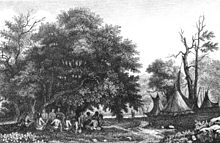Native American, Pre-European
Historical marker on the University of Florida campus
Eventually more complex social organization and agricultural practices emerged into what archaeologists classify as the Deptford culture (2500–100 BC). A Deptford culture campsite has been excavated beneath the subsequent Alachua culture "Law School Burial Mound" on the grounds of the University of Florida.[17] Around the 1st century AD, Deptford people began moving into the environs of Gainesville to take advantage of wetlands in the environs of Paynes Prairie and northern Orange Lake, becoming the Cades Pond culture.[18]
Timucua teepee village in Florida circa 1562
Alachua culture villages budded off to form clusters connected by a series of forest trails, many of which are still in use as paved roads;[20] among these clusters are some in the present city limits of Gainesville near the Devil's Millhopper and near Moon Lake (the eastern shore of which is 0.4 miles (0.64 km) from the city limits[geo note 1]) as well as northwest of and north-central of Paynes Prairie, and west of Newnans Lake.[21]
In the recorded period, the region was home to the Potano, a Timucua chiefdom descended from Alachua culture people (the town of Potano was in what is now the San Felasco Hammock northwest of Gainesville).[22]
European colonialization
Hernando de Soto and his army passed through Gainesville in August 1539 towards the beginning of their four-year exploration of what is now the southeastern United States, the third village where they stayed, Utinamocharra, having been in the dense cluster east of Moon Lake[23] at the northwestern edge of present-day Gainesville.The Native Americans, having little resistance to diseases introduced from Europe, declined significantly in number after the arrival of Europeans, and Spanish suppression of native revolts further reduced the population.
The remaining Timucua were converted to Roman Catholicism and organized into missions overseen by Franciscan priests.[24] The Mission San Francisco de Potano, the first doctrina (a mission with a resident priest) in Florida west of the St. Johns River, was founded in 1606 at the south edge of present-day San Felasco Hammock Preserve State Park.[25] In or adjacent to present-day Gainesville were two other missions (each named for the saint's day the first Mass was said in it[26]), Santa Ana and San Miguel, which were south of and within a day's walk from San Francisco,[26] and are thought to be in the cluster east of Moon Lake where Spanish and Indian artifacts from the Mission-period have been found.[27] The earliest missions were apparently established adjacent to native villages visited by De Soto's expedition; Santa Ana is thought to be located where Utinamocharra lay, and in 1606 the friar who served as the priest was told of cruelties that the chief, when a boy, had suffered from De Soto's men.[28] Chief Potano's town was relocated in the colonial period to the vicinity of the Devil's Millhopper, which is now inside the Gainesville city limits, from the western shore of Orange Lake.[23]
In the first decade of the 18th century, however, colonial soldiers from the Province of Carolina and their Yamasee Indian allies[29] had killed or carried off nearly all the remaining native inhabitants (10,000 − 12,000 native Floridians were taken as slaves, according to the governor of Spanish Florida) and the few remaining Timucua fled and ended up living in the vicinity of St. Augustine.[30]
Spanish colonists began cattle ranching in the Paynes Prairie area using Timucua labor,[31] and the largest hacienda (ranch) became known as La Chua (which combines the Spanish definite article La with the Timucuan word Chua, meaning "sinkhole"[32]). Although La Chua was destroyed by the above-mentioned raiders from Carolina, the ranch nevertheless gave its name to the Alachua band of the Seminole tribe who settled in the region in the 18th century under the leadership of the great chief Ahaya the Cowkeeper.[33]
Between 1763 and 1784 what is now Gainesville fell within the jurisdiction of the colony of British East Florida.[34]


No comments:
Post a Comment